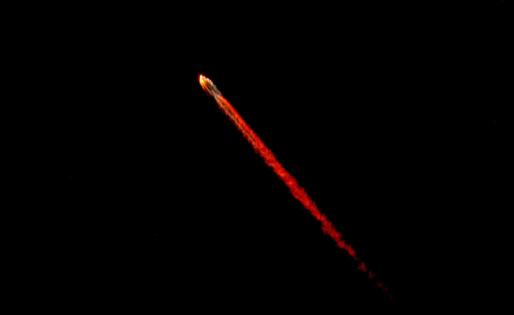How a chunk of a SpaceX rocket wound up behind a Polish warehouse
Published in Science & Technology News
Adam Burucki had a very peculiar Wednesday morning. Upon arriving at his warehouse in the quaint Polish village of Komorniki, he discovered that a massive chunk of charred rocket debris had crash-landed on his property.
Flabbergasted by the discovery, he called the police in the nearby city of Poznan, the BBC reported.
The police, working alongside the Polish Space Agency, known as POLSA, then determined that the 3-by-5-foot object was from a Falcon 9 rocket manufactured by Elon Musk's company SpaceX, according to the news outlet. Police also said that a similar piece of debris was found near the village of Wiry, about 2½ miles from Komorniki.
The rocket was launched Feb. 1 from Vandenberg Space Force Base in Santa Barbara County and carried 22 Starlink satellites into orbit, according to a statement from POLSA. The Falcon 9 rocket is designed to transport people and cargo into space and then safely reenter Earth's atmosphere.
However, at 4:46 a.m. local time Wednesday, the second stage of the rocket made an uncontrolled reentry over Poland, POLSA said. During this time, fragments of the rocket burning up as fireballs could be seen in the skies over the country, according to the Polish Press Agency and videos shared on social media.
The second stage is the upper portion of the rocket and is responsible for delivering items into orbit after the first stage has successfully propelled the rocket into Earth's upper atmosphere and detached itself.
In a Falcon 9 rocket, the first stage separates from the second stage about 2 minutes and 30 seconds after liftoff. The first stage is designed to be reusable, while the second stage is expendable and replaced after each mission.
Harvard University astrophysicist Jonathan McDowell in his online Space Report identified the debris found on Burucki's property as a composite overwrapped pressure vessel from the second stage. This is a high-strength container used to store helium gas, which is critical for pressurizing the rocket's propellant tanks and ensuring proper fuel flow to its engines.
UCLA astronomy professor Edward Wright told The Times it was likely that an engine or controls failure prevented the second stage from reentering Earth's atmosphere in a controlled manner and making a routine landing in the Pacific Ocean. Most of the rocket combusted in the intense heat created by the friction of hurtling through the atmosphere at 18,000 mph, he said.
McDowell noted that this was the fourth recent problematic incident with the SpaceX Falcon.
"So far, we've been lucky and no one has been hurt," he told the BBC, "but the more we put into the Earth's orbit, the more likely it is that our luck will run out."
In July, a Falcon 9 second stage experienced an oxygen leak, leading to engine problems and the premature release of 20 satellites. In August, the rocket's reusable first stage toppled into the ocean during a failed routine landing on a seafaring barge. Then during a NASA astronaut rescue mission in September, the Falcon 9's second stage experienced an abnormal deorbit burn, which caused it to land outside the intended area.
The Falcon 9 holds the record for the highest number of launches and reuses in U.S. history. It has made 391 landings since its launch in 2010, according to SpaceX. The company did not immediately respond to a request for comment on the debris found in Poland.
©2025 Los Angeles Times. Visit at latimes.com. Distributed by Tribune Content Agency, LLC.







Comments